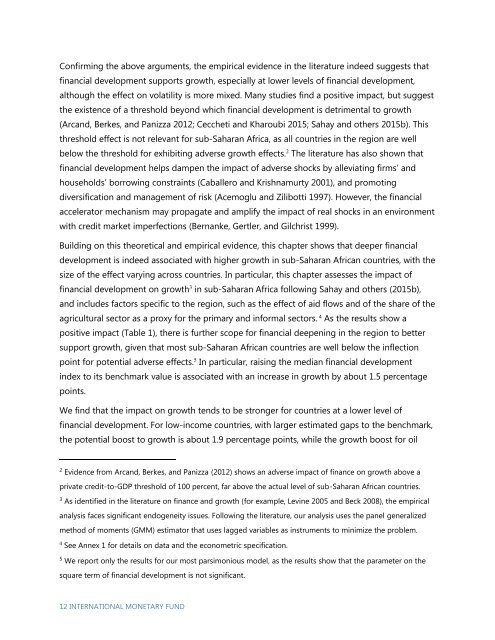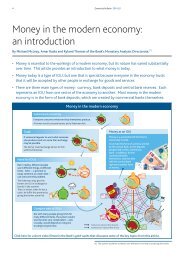Financial Development in Sub-Saharan Africa
dtxT305L5O2
dtxT305L5O2
Create successful ePaper yourself
Turn your PDF publications into a flip-book with our unique Google optimized e-Paper software.
Confirm<strong>in</strong>g the above arguments, the empirical evidence <strong>in</strong> the literature <strong>in</strong>deed suggests that<br />
f<strong>in</strong>ancial development supports growth, especially at lower levels of f<strong>in</strong>ancial development,<br />
although the effect on volatility is more mixed. Many studies f<strong>in</strong>d a positive impact, but suggest<br />
the existence of a threshold beyond which f<strong>in</strong>ancial development is detrimental to growth<br />
(Arcand, Berkes, and Panizza 2012; Ceccheti and Kharoubi 2015; Sahay and others 2015b). This<br />
threshold effect is not relevant for sub-<strong>Saharan</strong> <strong>Africa</strong>, as all countries <strong>in</strong> the region are well<br />
below the threshold for exhibit<strong>in</strong>g adverse growth effects. 2 The literature has also shown that<br />
f<strong>in</strong>ancial development helps dampen the impact of adverse shocks by alleviat<strong>in</strong>g firms’ and<br />
households’ borrow<strong>in</strong>g constra<strong>in</strong>ts (Caballero and Krishnamurty 2001), and promot<strong>in</strong>g<br />
diversification and management of risk (Acemoglu and Zilibotti 1997). However, the f<strong>in</strong>ancial<br />
accelerator mechanism may propagate and amplify the impact of real shocks <strong>in</strong> an environment<br />
with credit market imperfections (Bernanke, Gertler, and Gilchrist 1999).<br />
Build<strong>in</strong>g on this theoretical and empirical evidence, this chapter shows that deeper f<strong>in</strong>ancial<br />
development is <strong>in</strong>deed associated with higher growth <strong>in</strong> sub-<strong>Saharan</strong> <strong>Africa</strong>n countries, with the<br />
size of the effect vary<strong>in</strong>g across countries. In particular, this chapter assesses the impact of<br />
f<strong>in</strong>ancial development on growth 3 <strong>in</strong> sub-<strong>Saharan</strong> <strong>Africa</strong> follow<strong>in</strong>g Sahay and others (2015b),<br />
and <strong>in</strong>cludes factors specific to the region, such as the effect of aid flows and of the share of the<br />
agricultural sector as a proxy for the primary and <strong>in</strong>formal sectors. 4 As the results show a<br />
positive impact (Table 1), there is further scope for f<strong>in</strong>ancial deepen<strong>in</strong>g <strong>in</strong> the region to better<br />
support growth, given that most sub-<strong>Saharan</strong> <strong>Africa</strong>n countries are well below the <strong>in</strong>flection<br />
po<strong>in</strong>t for potential adverse effects. 5 In particular, rais<strong>in</strong>g the median f<strong>in</strong>ancial development<br />
<strong>in</strong>dex to its benchmark value is associated with an <strong>in</strong>crease <strong>in</strong> growth by about 1.5 percentage<br />
po<strong>in</strong>ts.<br />
We f<strong>in</strong>d that the impact on growth tends to be stronger for countries at a lower level of<br />
f<strong>in</strong>ancial development. For low-<strong>in</strong>come countries, with larger estimated gaps to the benchmark,<br />
the potential boost to growth is about 1.9 percentage po<strong>in</strong>ts, while the growth boost for oil<br />
2<br />
Evidence from Arcand, Berkes, and Panizza (2012) shows an adverse impact of f<strong>in</strong>ance on growth above a<br />
private credit-to-GDP threshold of 100 percent, far above the actual level of sub-<strong>Saharan</strong> <strong>Africa</strong>n countries.<br />
3<br />
As identified <strong>in</strong> the literature on f<strong>in</strong>ance and growth (for example, Lev<strong>in</strong>e 2005 and Beck 2008), the empirical<br />
analysis faces significant endogeneity issues. Follow<strong>in</strong>g the literature, our analysis uses the panel generalized<br />
method of moments (GMM) estimator that uses lagged variables as <strong>in</strong>struments to m<strong>in</strong>imize the problem.<br />
4<br />
See Annex 1 for details on data and the econometric specification.<br />
5<br />
We report only the results for our most parsimonious model, as the results show that the parameter on the<br />
square term of f<strong>in</strong>ancial development is not significant.<br />
12 INTERNATIONAL MONETARY FUND





